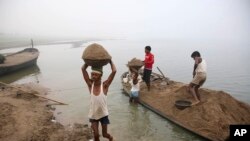The killing of a reporter in India’s Uttar Pradesh state has exposed the dangers for journalists covering illegal sand mining and construction in the country.
Shubham Mani Tripathi, a correspondent for the Hindi-language daily Kampu Mail, was shot dead June 19 while returning home on his motorcycle.
Days before he died, Tripathi said in a Facebook post that he feared for his life because of his reporting, the media watchdog Reporters Without Borders (RSF) said.
Tripathi covered India’s “sand mafia” – powerful networks that illegally mine sand from riverbeds to sell to the construction sector. He also reported on an illegal construction project that was later demolished as a result of his investigation.
Corrupt industry
The sand mining industry is laden with corruption, said Daniel Bastard, head of RSF’s Asia-Pacific desk. This puts journalists who cover the topic at an increased danger, he told VOA.
“It creates a lot of corruption – corruption of the police, corruption of the politicians and corruption of businessmen,” Bastard said. “So you have a real network of people who don't want to listen to the state on this.”
Sand mining is one of the biggest extraction industries in the world, providing a key material for the construction industry. Several countries have limited or regulated the business because of damage to the environment – more than 20 Indonesian islands have disappeared since 2005, according to the Pulitzer Center.
Greater regulation and export bans have led to illegal operations run by sand mafias, which are accused of killing police, journalists and government officials who try to expose or stop them.
RSF cited the deaths of several journalists in India who it said were killed in retaliation for their coverage of illegal sand mining or land disputes. Other journalists have been threatened or harassed, including Sandhya Ravishankar. In 2017, she was trolled and doxed – attackers posted her personal information online – after Ravishankar investigated illegal sand mining for The Wire.
In part, attacks like these are due to the lack of protection for Indian journalists in rural areas, like Uttar Pradesh, Bastard said.
“The application of the law is very bad, especially in rural areas, and especially in the state of Uttar Pradesh, in northern India, where this happened,” Bastard said.
In Tripathi’s case, police have arrested three people and identified the suspected mastermind: Divya Awasthi, a businesswoman whose illegal construction project was demolished after Tripathi wrote about it.
Two men were arrested on suspicion of shooting the journalist, and a co-conspirator was detained and accused of ordering a fourth person to pay the assailants for the killing, according to a police press release cited by the Committee to Protect Journalists.
Police have offered a reward for help locating Awasthi.
“The arrests of three suspects in Shubham Mani Tripathi’s killing is a good start, but police must also find the mastermind and all those involved, and hold them all to account,” Steven Butler, CPJ’s Asia program coordinator, said in a statement.
Press freedom suffering
The killings of journalists covering illegal activities come as India’s press freedom record declines. In RSF’s 2020 World Press Freedom Index, India ranked 142nd out of 180 countries, with No. 1 being the most free. Its ranking has declined nine spots since 2016.
This decline is in part due to how authorities investigate the attacks of journalists, Bastard said. Sand mafia bosses often have links to police chiefs, and investigations into violence against journalists are “almost always closed without further action,” he said.
“This creates a kind of vicious circle of impunity,” Bastard said. “And it is very, very bad for press freedom and freedom to inform.”






